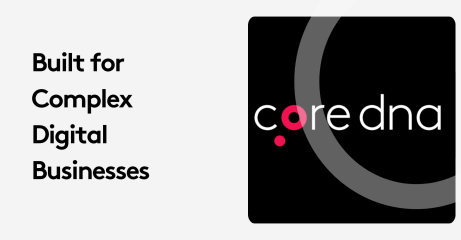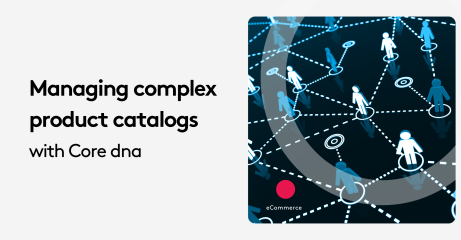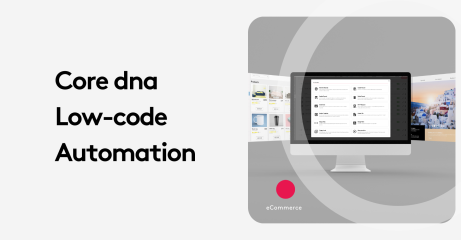B2B eCommerce KPIs: The Hidden Metrics Fueling Growth

Revenue and conversion rates are just the tip of the iceberg. The real growth drivers in B2B eCommerce lie in overlooked KPIs that reveal customer behavior, efficiency gaps, and untapped opportunities.
Commerce is growing rapidly and is expected to continue at this pace for the foreseeable future. So, what does this mean for your eCommerce business? After all, eCommerce isn’t just about selling your products online. It’s about driving growth and demand for your business and making it as convenient as possible for your customers. Key Performance Indicators, or KPIs, quantify the performance of your business in relation to the expectations of your customers, suppliers, competitors, and shareholders.
So, what exactly is a KPI?
There is an infinite number of metrics a B2B eCommerce could list as a KPI. It’s not uncommon for a start-up or even a large successful business to miss the mark on which KPIs they should measure.
Key takeaways
- Importance of KPIs: Tracking Key Performance Indicators (KPIs) is essential for measuring and improving B2B eCommerce performance.
- Key Metrics to Monitor: Crucial KPIs include Customer Retention Rate (CRR), Conversion Rate, Online Order Frequency, Site Traffic, and Return on Investment (ROI).
- Impact on Business Growth: Proper KPI tracking helps businesses optimize marketing strategies, customer experience, and overall operational efficiency.
- Core dna's Role: The platform provides comprehensive KPI tracking tools to improve conversion rates, analyze sales sources, monitor funnel performance, and measure content effectiveness.
On this page:
According to Think with Google, “95% of leading marketers agree that ‘to truly matter,' marketing analytics KPIs must be tied to broader business goals.’’
Also, it is a necessity to categorize your KPIs under where in the business they fall (e.g., marketing, sales, financials) to manage your company’s progress more strategically and clearly. The infamous SMART criteria (George Doran, Arthur Miller, and James Cunningham, 1981) should also apply to eCommerce KPIs, meaning they should be specific, measurable, assignable, relevant, and time-bound.
1. Customer Retention Rate (CRR)
The customer retention rate measures how long current consumers stay loyal to a brand or how many customers continue to purchase from your company. On the contrary, the churn rate indicates how many customers you lose within a particular time.
Here’s a simple equation you can use to calculate your churn rate as a percentage:
Churn rate = Total customers - # of customers (end month)/ # of customer (beginning of month) x 100
For usage metrics, the CRR can give insight into “stickiness,” or the average proportion of daily/weekly/monthly active users who return or continue to purchase from you. For vendor metrics, CRR can give insight into the overall performance of your product or service.
2. Conversion Rate
A conversion is any desired action from the user. This might range from a simple button click to a purchase and becoming a client. The conversion rate is calculated as follows:
Conversion rate = Total visitors/number of conversion x 100
Shopping cart abandonment is a conversation rate that you can analyze to see how often a user doesn’t complete a purchase after starting the checkout process. To find this, use the following formula:
Shopping cart abandoned rate (CAR) = Completed transaction/# of cart x 100
Conversation rates can even provide insight into the effectiveness of your marketing campaigns. For example, the subscribed vs. unsubscribed rate can give you information about how customers react and engage with marketing emails. Unengaged subscribers won't react to your emails, and those who don't want to hear from you will unsubscribe. The unsubscribe rate tells you whether your emails meet your audience's expectations.
Many factors can impact your conversation rates, from competitor pricing to the customer experience. These are all factors to consider when looking for ways to increase your conversation rates and make decisions on email campaigns.
3. Online Order Frequency
Average Order Value (AOV) is a metric that calculates the average sum of all orders made with a business during a specific time. For eCommerce businesses, this would also be considered the average online order value of sales.
Examining your online order frequency metrics can tell you vital information about peak times and days customers are ordering from you or even which offers and promotions attract more buyers. Furthermore, you can examine the average time to process said orders, which can significantly impact customer satisfaction.
Ronald Coase once said, “If you torture the data long enough, it will confess to anything.” Analyzing this data and calculating these statistics can drive decisions about how to grow your eCommerce business.
4. Site Traffic
Using trafficking tools to examine your site traffic can provide detailed information about how visitors engage and interact with your B2B eCommerce platform or presence.
When it comes to getting users to take action on your landing page, one of the most important metrics to keep track of is the organic click-through rate (CTR). Your CTR tells you how many people clicked on your landing page for every 100 people who saw it. Clicks are the key to landing page conversions, so knowing how many people click on your page can tell you a lot about your landing page's effectiveness.
Your site’s bounce rate is another important KPI. Having a high bounce rate means that most users leave your website without signing up, clicking on other parts of it, completing the payment process, or doing any kind of action. If many visitors leave your website without taking any action, it’s an indication that your landing page isn’t effective, and you need to improve it.
Finally, the number of return visits can provide insight into how many customers are returning to your eCommerce site after visiting it previously in a specific time period. You should track this KPI because your website's performance depends on knowing your visitors – why they return, what interests them, etc. Increasing return visitors increases your chances of converting them into customers.
5. Return on Investment (ROI)
Businesses require financial goals to operate and grow, and eCommerce businesses are no exception. To help you stay on track, it’s essential to know what financial metrics are available to you. Return on Investment (ROI) is a term used to measure your money's efficiency. Use this simple equation to calculate your ROI:
ROI = Revenue/Cost
The cost performance index (CPI) KPI measures a project's financial efficiency of budgeted resources. This metric can tell you if a project is over budget or performing well. Here’s how to calculate it:
CPI = Earned value/Actual Cost
Cost variance (CV) is the difference between actual and planned costs. This formula helps project managers determine budget overruns:
CV = Budgeted cost/Actual costs
Customer acquisition cost (CAC) is the amount of money a company spends to acquire a new customer. It aids in calculating the ROI of attempts to expand their customer base. To calculate your CAC, use this formula:
CAC = Overall costs to acquire customers/Total # of customers gained
6. Net Promoter Score (NPS)
The “net promoter” concept has been around for some time now. It has been one of the most popular indicators of a company’s customer loyalty and satisfaction, and it is used in countless industries, from banking to retail. It measures how likely a person is to recommend your company to others. The higher the NPS, the more likely that person will advocate for your company.
When calculating your business’s NPS score, you can place customers into one of three categories.
- Detractors: Think of these as dissatisfied customers that could potentially damage your brand through word-of-mouth.
- Passives: These are satisfied but unenthusiastic customers.
- Promoters: These are satisfied and enthusiastic customers that are likely to recommend your business to others.
To calculate the NPS, use the following formula:
NPS = Total % of detractors from the total % of promoters
How this sample company eCommerce platform helps with KPI tracking
7. Conversion
The sample company platform provides information about the conversion of products to cart, the conversion of checkouts, and the sales funnel.
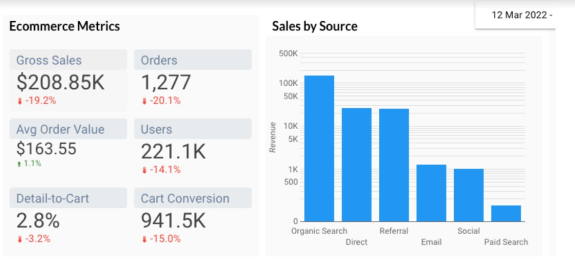
8. Sales Source and Advertising Performance
The sample company platform provides information about sales by source and Google Ads Metrics.
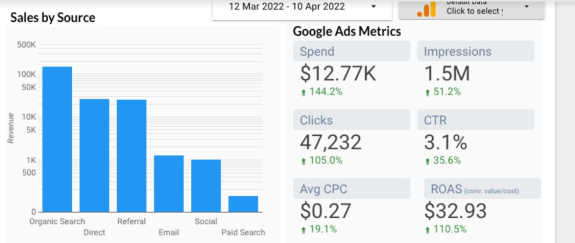
9. Funnel KPIs
Funnel KPIs provided by the sample company platform can measure the efficiency and success of the sales workflow.

10. Content-related KPIs
The sample company platform provides information about how content performs with search engines and where content and visitors are arriving from.
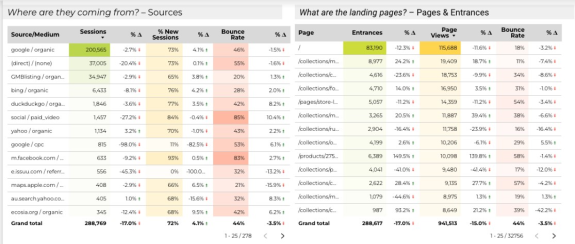
Final Thoughts
In the world of business, especially B2B eCommerce, it’s important to track performance to stay on track and improve over time. In other words, you want to know whether your business is moving in the right direction. In the words of Peter Drucker, “If you can’t measure it, you can’t improve it.’’
KPIs are the most important tool for comprehending your B2B eCommerce ecosphere and then addressing what the next steps are from the detracting results.










